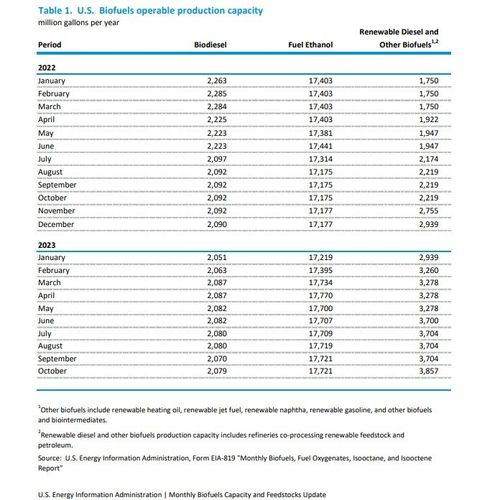EIA: US biofuel capacity, feedstock consumption up in October

SOURCE: U.S. Energy Information Administration
January 2, 2024
BY Erin Voegele
U.S. operable biofuels production capacity expanded in October, with gains for both renewable diesel and biodiesel, according to data released by the U.S. Energy Information Administration on Dec. 29. Feedstock consumption was also up.
Total operable biofuels capacity reached 23.657 billion gallons per year in October, up from 23.495 billion gallons per year the previous month and 21.486 billion gallons per year in October 2022.
Capacity for renewable diesel and associated fuels, which includes renewable heating oil, renewable jet fuel, renewable naphtha, renewable gasoline and other biofuels and biointermediates, reached 3.857 billion gallons per year in October, up 153 MMGy when compared to the previous month and up 1.638 billion gallons per year when compared to October 2022.
Ethanol capacity was at 17.721 billion gallons per year in October, a level maintained from the previous month. When compared to October 2022, ethanol capacity was up 546 MMgy.
Advertisement
Biodiesel capacity expanded to 2.079 billion gallons per year in October, up 9 MMgy when compared to September, but down 13 MMgy compared to October 2022.
U.S. biofuel producers consumed 28.819 billion pounds of feedstock in October, up from 27.417 billion pounds in September and 27.578 billion pounds in October 2022, according to the EIA.
Approximately 25.762 billion pounds of corn went to biofuel production in October, up from 24.088 billion pounds the previous month and 25.123 billion pounds in October of the previous year. U.S. biofuel producers also consumed 116 million pounds of grain sorghum in October, down from 163 million pounds in September and 325 million pounds in October 2022.
A total of 1.062 billion pounds of soybean oil went to biofuel production in October, including 645 million pounds consumed by biodiesel plants and 416 million pounds consumed by renewable diesel facilities. Biofuel producers consumed 1.207 billion pounds of soybean oil in September, including 620 million pounds consumed by biodiesel producers and 587 million pounds consumed by renewable diesel producers in September, and 906 million pounds in October 2022, including 640 million pounds consumed by biodiesel producers and 266 million pounds consumed by renewable diesel facilities.
Approximately 324 million pounds of corn oil was used to produce biofuels in October, down from 373 million pounds in September, but up from 285 million pounds in October 2022. In addition, 286 million pounds of canola oil was used to produce biofuels in October, up from 285 million pounds in September and 167 million pounds in October of the previous year.
Advertisement
The EIA earlier this year began to break down canola oil and corn oil consumption by producer type. Biodiesel producers consumed 76 million pounds corn oil and 165 million pounds of canola oil in October, compared to 74 million pounds and 161 million pounds, respectively, in September. Renewable diesel facilities consumed 248 million pounds of corn oil and 120 pounds of canola oil in October, compared to 300 million pounds and 124 million pounds consumed, respectively, during the previous month.
An additional 7 million pounds of feedstock classified as “other vegetable oils” went to biofuel production in October, down from 16 million pounds in September.
Biofuel producers also consumed 668 million pounds of yellow grease, 450 million pounds of beef tallow, 53 million pounds of white grease and 15 million pounds of poultry fat in October. Consumption was at 641 million pounds, 508 million pounds, 47 million pounds and 17 million pounds, respectively, in September, and at 464 million pounds, 171 million pounds, 62 million pounds and 16 million pounds, respectively, in October 2022. An additional 17 million pounds of other forms of waste oils, fats and greases was consumed in October, down from 19 million pounds in September. The EIA withheld the volume of other oils, fats and greases that went to biofuel production in October 2022 in order to avoid disclosure of individual company data.
The EIA withheld data on feedstocks classified as other types of agriculture and forestry products, yard and food waste, and other feedstocks not elsewhere specified to avoid disclosure of individual company data.
Additional data is available on the EIA website.
Related Stories
IAG and Microsoft are extending their 2023 co-funded purchase agreement for SAF by five years. The SAF used under the agreement will be produced by Phillips 66’s Humberside refinery and LanzaJet’s facility in the U.S.
U.S. exports of biodiesel and biodiesel blends of B30 or greater fell to 7,849.6 metric tons in February, according to data released by the USDA Foreign Agricultural Service on April 3. Biodiesel imports were at 21,964.9 metric tons for the month.
Neste and DB Schenker, a logistics service provider, have collaborated to work towards expanding DB Schenker’s adoption of Neste MY Renewable Diesel in Asia-Pacific. DB Schenker trialed the fuel from December 2024 to February 2025 in Singapore.
The International Air Transport Association has launched the Sustainable Aviation Fuel (SAF) Registry with its release to the Civil Aviation Decarbonization Organization. The registry is now live and under CADO management.
Varo Energy, a European energy company based in Switzerland, on March 31 announced an agreement to acquire Preem, a Sweden-based petroleum and biofuels company that is developing additional renewable diesel and SAF capacity.
Upcoming Events










